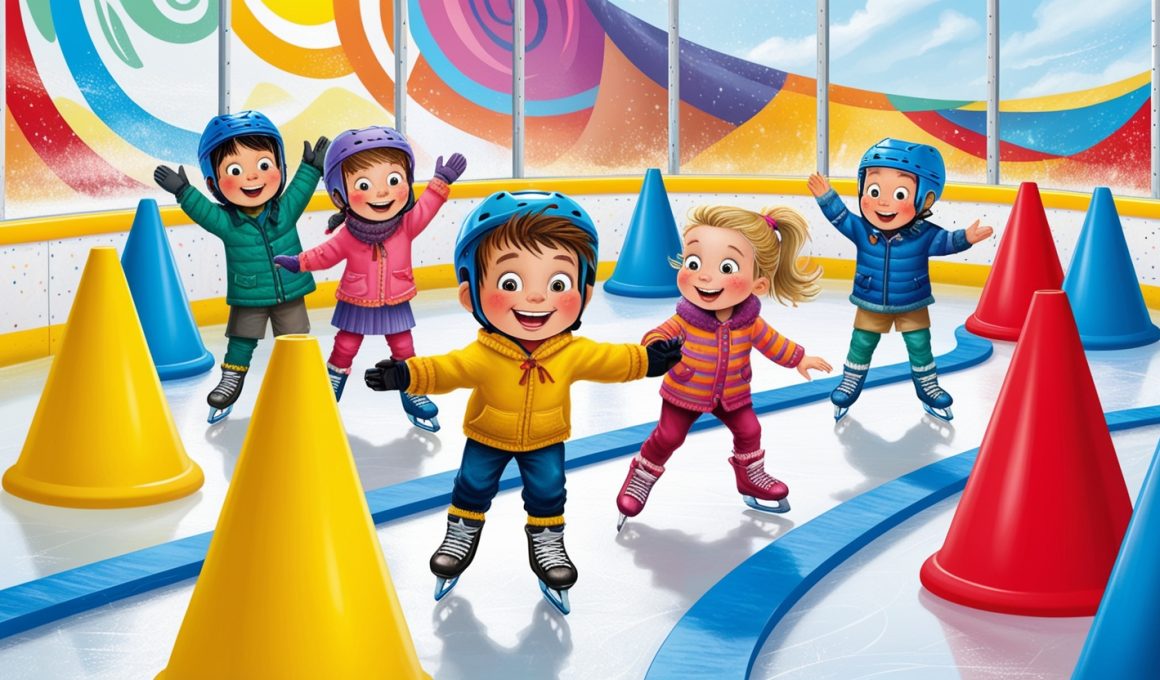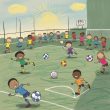Teaching a young child to skate can be challenging—for both the child and the parent. But through the PlayBoost™ formula, I’ve developed a set of engaging, kid-approved games that make learning to skate both fun and effective.
Why Setting the Right Foundation Matters
The key to helping kids learn to skate is building their confidence, creating an environment where they’re comfortable moving on the ice, and helping them embrace falling as a natural part of the learning process.
Create a Welcoming Environment
A child’s comfort level significantly impacts their willingness to explore new movements on the ice. Coaches should create a welcoming atmosphere by greeting kids with a big smile, calling them by name, and using enthusiasm to keep things light and exciting. A warm welcome can help reduce anxiety and encourage participation.
Equip Them for Success
Learning to skate means kids will fall—a lot. The right equipment makes all the difference. Full hockey gear (especially shin pads, hockey pants, and helmets) protects kids from the impact of falls, helping them feel secure enough to test their edges, which is essential for skill-building.
Foster a Growth Mindset
Building resilience and a growth mindset starts even before hitting the rink. Parents and coaches can encourage kids by praising their efforts instead of focusing solely on outcomes. When kids believe they can improve with practice, they’re more likely to welcome the challenges skating brings.
Use Engaging, Fun Games
Traditional skating drills can feel intimidating and monotonous. Instead, think of activities as immersive games that keep kids engaged and eager to test their boundaries on the ice. Here are my top game picks for teaching young kids to skate.
The Best Games for Teaching Kids to Skate
#1 – Find the Stuffies
This game is always a hit with young skaters!
How to Play:
Place small stuffed animals under cones on the far side of the ice, ensuring there’s one for each child. When you give the “Go!” signal, kids will skate across, lift cones to find the stuffed animal, and bring it back to you.
Pro Tip: Encourage kids to keep their balance by bending at the knees and hips rather than dropping to the ice.
Variation: After returning their stuffed animals, kids search for their hockey sticks (scattered across the ice), then score a goal. Another coach can re-hide the animals, allowing the game to continue.
Benefits: Kids become excited to skate faster to find the hidden animals, naturally working on balance, speed, and coordination. The game’s playful hide-and-seek style keeps them engaged and motivated.
#2 – Simon Says
A childhood classic, Simon Says introduces new skating movements in a fun, structured way.
How to Play:
The coach uses “Simon Says” to instruct different movements, like balancing on one leg or skating backward. Kids only follow the instructions if prefaced with “Simon Says.”
Note: Instead of eliminating kids who make mistakes, keep everyone moving. This keeps the energy high and maximizes participation.
Benefits: By framing the movements as part of a game, kids are more willing to try new skills. This game is perfect for working on everything from single-leg balance to marching and even backward skating.
#3 – Obstacle Courses
Turning traditional cone drills into obstacle courses adds an element of excitement that keeps kids engaged.
How to Set Up:
Create a path with obstacles, like cones, that kids can follow, adding elements like:
- Zig-Zags: Navigate cones to improve edge work.
- Slide Under: Position a low barrier for kids to slide under.
- Duck Under: Set up a barrier they can duck under by bending their knees.
- Jump Over: Draw lines on the ice for kids to jump over.
- Single-Leg Glide: Designate sections for one-leg gliding.
- Ice Scraping: Draw shapes or animals on the ice that kids “scrape off” to practice stopping.
- Stop Sign: Place a stop sign along the course to cue a full stop before continuing.
Benefits: An obstacle course provides endless possibilities and encourages kids to explore new movements in a playful way. It’s an ideal setup for helping them learn different techniques without the pressure of “drills.”
#4 – Mr. Wolf
Games that incorporate a chase element, like “Mr. Wolf,” naturally encourage proper skating strides as kids try to move quickly across the ice.
How to Play:
The coach stands near the finish line facing away from the kids. The kids call out, “What time is it, Mr. Wolf?” and the coach responds with a time, like “five o’clock.” Kids then take that number of strides forward. At any moment, the coach can call out “Lunch Time!” and chase the kids back to the starting line.
Variations: Give kids a turn to play Mr. Wolf—this role reversal keeps them excited and engaged.
Benefits: This game helps kids work on stops, starts, and skating speed—all essential skating skills.
Those are 4 of my favorite games to use with my Learn to Skate Hockey groups.
But one thing I want all parents and coaches to realize:
Kids must develop ankle strength and stability to support their weight on their edges. The best way to help kids develop these skills is through lots of play. This can be unstructured play at playgrounds and in the outdoors or fun athletic-based games like those in our ADG PlayBoost Games Library.
If you have a young kid who wants to learn to skate, I highly recommend checking out some of our jumping and agility games in the ADG PlayBoost Games Library!

